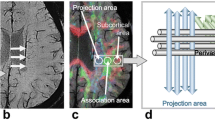Abstract
Our objective was to follow the course of a dysmyelinating disease followed by partial recovery in transgenic mice using non-invasive high-resolution (117 × 117 × 70 μm) magnetic resonance (μMRI) and evoked potential of the visual system (VEP) techniques. We used JOE (for J37 golli overexpressing) transgenic mice engineered to overexpress golli J37, a product of the Golli–mbp gene complex, specifically in oligodendrocytes. Individual JOE transgenics and their unaffected siblings were followed from 21 until 75-days-old using non-invasive in vivo VEPs and 3D T2-weighted μMRI on an 11.7 T scanner, performing what we believe is the first longitudinal study of its kind. The μMRI data indicated clear, global hypomyelination during the period of peak myelination (21–42 days), which was partially corrected at later ages (>60 days) in the JOE mice compared to controls. These μMRI data correlated well with [Campagnoni AT (1995) “Molecular biology of myelination”. In: Ransom B, Kettenmann H (eds) Neuroglia—a Treatise. Oxford University Press, London, pp 555–570] myelin staining, [Campagnoni AT, Macklin WB (1988) Cellular and molecular aspects of myelin protein gene-expression. Mol Neurobiol 2:41–89] a transient intention tremor during the peak period of myelination, which abated at later ages, and [Lees MB, Brostoff SW (1984) Proteins in myelin. In: Morell (ed) Myelin. Plenum Press, New York and London, pp 197–224] VEPs which all indicated a significant delay of CNS myelin development and persistent hypomyelination in JOE mice. Overall these non-invasive techniques are capable of spatially resolving the increase in myelination in the normally developing and developmentally delayed mouse brain.





Similar content being viewed by others
References
Campagnoni AT (1995) Molecular biology of myelination. In: Ransom B, Kettenmann H (eds) Neuroglia—a treatise. Oxford University Press, London pp 555–570
Campagnoni AT, Macklin WB (1988) Cellular and molecular aspects of myelin protein gene-expression. Mol Neurobiol 2:41–89
Lees MB, Brostoff SW (1984) Proteins in myelin. In: Morell (ed) Myelin. Plenum Press, New York and London, pp 197–224
deFerra F, Engh H, Hudson L et al (1985) Alternative splicing accounts for the four forms of myelin basic protein. Cell 43:721–727
Roach A, Boylan K, Horvath S et al (1983) Characterization of cloned cDNA representing rat myelin basic protein: absence of expression in brain of shiverer mutant mice. Cell 34:799–806
Takahashi N, Roach A, Teplow DB et al (1985) Cloning and characterization of the myelin basic protein gene from mouse: one gene can encode both 14 kd and 18.5 kd MBPs by the alternate use of exons. Cell 42:139–148
Campagnoni AT, Pribyl TM, Campagnoni CW et al (1993) Structure and developmental regulation of Golli–Mbp, a 105-kilobase gene that encompasses the myelin basic-protein gene and is expressed in cells in the oligodenrocyte lineage in the brain. J Biol Chem 268: 4930–4938
Campagnoni AT, Skoff RP (2001) The pathobiology of myelin mutants reveals novel biological function of the MBP and PLP genes. Brain Pathol 11:74–91
Reyes SD, Givogri MI, Campagnoni C et al (2003) Overexpression of the golli J37 isoform in transgenic mice results in CNS hypomyelination. Abstr-Soc. Neurosci 141.17
Jacobs EC (2005) Genetic alterations in the mouse myelin basic proteins result in a range of dysmyelinating disorders. J Neurol Sci 228:195–197
Martin M, Hiltner T, Wood J, Fraser S, Jacobs R, Readhead C (2006) Myelin deficiencies visualized in vivo: visually evoked potentials and T2-weighted MR images of Shiverer mutant and wild type mice. Accepted in J Neurosci Res
Strain GM, Tedford BL (1993) Flash and pattern-reversal visual-evoked potentials in C57BL/6J and B6CBAF1/J mice. Brain Res Bull 32:57–63
Norris DG (1991) Magn Reson Med 17:539–542
Hume AL, Waxman SG (1988) Evoked potentials in suspected multiple sclerosis—diagnostic-value and prediction of clinical course. J Neurol Sci 83:191–210
Matthews WB (1985) Clinical aspects. In: Matthews WB et al (eds) McAlpines’s multiple sclerosis. 49 Churchhill Livingstone, Edinburgh
Chiappa KH (1983) Evoked potentials in clinical medicine. Raven Press, New York
Halliday AM, McDonald WI, Mushin J (1973) Visual evoked-response in diagnosis of multiple-sclerosis. Brit Med J 4:661–664
Kaur J, Libich DS, Campagnoni CW et al (2003) Expression and properties of the recombinant murine Golli–Myelin basic protein isoform J37. J Neurosci Res 71:777–784
Dupouey P, Jacque C, Bourre JM et al (1979) Immunocytochemical studies of myelin basic protein in shiverer mouse devoid of major dense line of myelin. Neurosci Lett 12:113–118
Acknowledgments
The authors would like to acknowledge funding from the NIH NEI (R01-EY011933) and NINDS (R01-NS23022 and R01-NS46337) and NSERC and Xiaowei Zhang for assistance with MRI.
Author information
Authors and Affiliations
Corresponding author
Additional information
Special Issue in honor of Anthony and Celia Campagnoni
Rights and permissions
About this article
Cite this article
Martin, M., Reyes, S.D., Hiltner, T.D. et al. T2-weighted μMRI and Evoked Potential of the Visual System Measurements During the Development of Hypomyelinated Transgenic Mice. Neurochem Res 32, 159–165 (2007). https://doi.org/10.1007/s11064-006-9121-z
Accepted:
Published:
Issue Date:
DOI: https://doi.org/10.1007/s11064-006-9121-z




